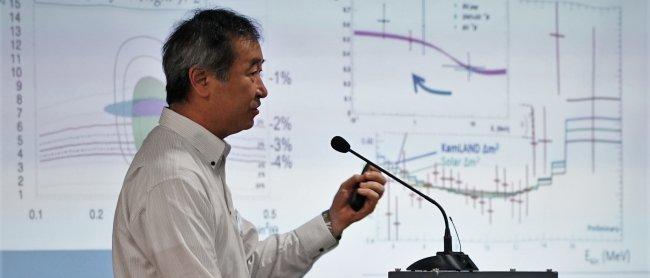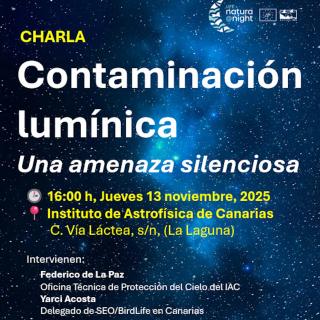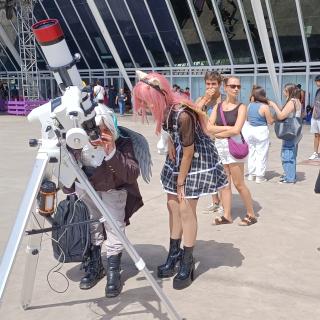High energy gamma ray astronomy, gravitational waves, cosmology, and the connection of cosmic rays with telescopes which operate at different wavelengths have been the themes of the four sessions celebrated today in the Symposium “Frontiers of Particle Physics” celebrated in Los Cancajos (La Palma) the day after the official inauguration of the LST-1 telescope at the Roque de los Muchachos Observatory.
Werner Hofmann, of the Max Planck Institute for Theoretical Physics (Germany) opened the first sesión with an introductory talk about the CTA (Cherenkov Telescope Array) in the context of gamma ray astronomy, recalling the history of this field. He talked about the current scientific installations set up to study in this energy range, CANGAROO, HESS, MAGIC y VERITAS- which have now been joined by the new LST-1 telescope, the prototype of the four large sized telescopes LST which will form a part of the Cherenkov Telescope array North.
After that Masahiro Teshima talked about the science which could be performed with the CTA array, and the LST telescopes. He concluded that these installations would have an enhanced sensitivity in the range 20 to 1000 GeV (gigaelectron volts) and unique sensitivity in the range 20 to 200 GeV, thus expanding our horizons for gamma rays. With this instrument it will be possible to study the origin of cosmic rays from both inside and outside our Galaxy, the accelertion of particles, high energy phenomena around black holes, and a search for dark matter. He picked out especially the role that it will have in the detection of the “gamma ray bursters” (GRB’s), the bursts of gamma rays from active galactic nuclei( AGN), and neutrinos.
The session continued with the Principal Investigator for the CTA array in the Instituto de Astrofísica de Canarias (IAC), Ramón García López, who spoke in the name of the LST collaborations.He reviewed the process and the stages of the construction of the first LST now installed on La Palma, from the origins of the project, the established agreements, the site selection, the first stonelaying, with the presence of the Nobel Laureate in Physics 2015 Takaaki Kajita, who had only just been notified that he had received the award, and finally the inauguration of the LST which tool place yesterday with a ceremony following the known Japanese tradition of cutting ribbons. García López finally explained what the next steps in the collaboration would be on the Spanish side, at both scientific and technical levels.
Neutrino astrophysics
Nobel Laureate Takaaki Kajita of the Institute for Research in Cosmic Rays (ICRR) of the University of Tokyo gave a talk about the physics and the astrophysics of neutrinos with Cherenkov water detectors, and the results obtained during the 80’s and 90’s above all after the detection of neutrinos from the Supernova 1987ª and the observation of solar neutrinos with the Kamiokande detector using 50 tonnes of water, in 1988. “The Cherenkov water detectors (Kamiokande, IMB, Superkamiokande and SON) have played very important roles in the physics and astrophysics of neutrinos, and we would like to continue contributing in these fields with the next generation of Cherenkov water detectors Hyperkamiokande”.
Elisa Resconi, a researcher in the Physics Department at the Technical University of Munich commented on the most recent results on the origin of ultra-high energy cosmic particles.”The neutrinos of IceCube (the experiment which detected the first extremely high energy neutrinos of astrophysical origin in 2013) are opening a new window on the univers” specifically with two independent chanels for the study of difuse cosmic neutrinos, the first double cascade events, the first event which is a candidate for the Glashow resonance, and the strong evidence for the first non-stellar neutrino source, a blazar. “The frontier” she ended “ is a planetary scale neutrino telescope”, the result of uniting all the experiments in current operation with a new one planned for Canada.
Gravitational waves
Masatake Ohahsi,of the ICRR, University of Tokyo, gave a reporto on the present state of KAGRA, an underground laser interferometer 3 km long which uses cryogenic mirrors, and whose objective is to detect gravitational waves. “In the spring of 2019” he announced “we are hoping to complete the construction phase and move to the testing phase. KAGRA plans to join, in autumn 2019, the third operational phase of the LIGO and VIRGO detectors".
In the afternoon session dedicated to cosmology, Jan Tauber, the scientist in charge of the Planck project at the European Space Research and Technology Centre (ESTEC) presented the latest results obtained from this mission designed to study the Cosmic Microwave Background Radiation, the product of the Big Bang, and which has contributed to determine the basic parameters of cosmology: the age of the universe (13.8 thousand million years), the Hubble constant (67.4 km/s/Mpc) (a different value from that obtained by other astrophysical methods), the epoch of reionization (z = 7.7) the proportion of dark matter(26.6%) of baryonic (“normal”) matter, (4.09 %), and of dark energy (63.8%) in the Universe. He also mentioned future satellites such as CÖRE, Litebird, and Pixie, the ground-based telescopes such as the QUIJOTE experiment, and ghe future GroundBIRD, these two latter at the Teide Observatory in Tenerife. “The challenge now” he pointed out “is to reach a coherent picture among all the studies of the early and late universe”.
Ramon Miquel, a researcher at ICREA/IFAE (Institute of High Energy Physics), Barcelona, spoke about observational cosmology, in which structure formation is the most complicated question at the momento. To tackle this major surveys of galaxies on a large scale are needed. In his talk he concentrated on the topic of dark energy, possible the most difficult problem in fundamental physics, in in the actions which could be taken to understand it.
Synergies among telescopes
In the last session Javier Berdugo, a scientist at CIEMAT, in charge of the AMS (Alpha Magnetic Spectrometer) on the International Space Station commented on the present state of this instrument, installed on the International Space Station dedicated to the study of cosmic rays, dark matter and the search for traces of antimatter at the beginning of the universo. Since 2011 this instrument has been collecting data on the most violent events in the universe, as well as studying dark matter and searching for traces of primordial antimatter.
Romano Corradi, the director of the Gran Telescopio Canarias (GTC) closed the symposium by stating that to understand astrophysical phenomena it is necessary to observe at all possible wavelengths. “ Now it is not a marginal increment to observe one more wavelength, it is a crucial necessity for understanding the universo” In his talk he gave examples of what has been done in the visible and the infrared with a high energy phenomenon, with perspectives for what can be done in the future. “Synergy between different telescopes is necessary, because to study them from all points of view we need joint well-coordinated observations. This cannot be done by chance, it has to be planned previously. It will also be necessary to use intermediate scale telescopes, smaller than the CTA and the GTC, because there is a chain of observations which, without the intervention of these intermediate telescopes will never reach the GTC. Each telescope has a field and a reaction time which are different, so that one needs a very well planned strategy to go from the first observation, when a cosmic explosion is detected, to make a precise identification using small telescopes about where the objects are in the sky, to then move to the larger telescopes which allow us to detect all the possible details.
The extreme universe
Tomorrow, Friday 12th October will see the start of the course “The Extreme Universe seen in Very High Energy Gamma Rays, 2018”, organized by the ICRR Tokyo and the University of Tokyo, in which there will be discussions about the important role to be played by the CTA array in the development of multimessenger astronomy, and theoretical and observational aspects related to the study of the universo at the highest energies will be explained. Also, on October 12th and 13th there will be a meeting of the Astroparticle Physics International Forum (APIF), organized by The Kavli Institute for Particle Astrophysics and Cosmology (KIPAC), the SLAC National Accelerator Laboratory and the University de Stanford.
The IAC's actions in the CTA project are financed by the project "The four Large Size Telescopes (LST) of the CTA-North in the ORM" reference ESFRI-2017-IAC-12 of the Ministry of Science, Innovation and Universities, 85% co-financed with European Regional Development Funds (FEDER) of the Operational Programme for Intelligent Growth 2014-2020. This project is co-financed with Canary Islands Development Funds (FDCAN) from the Cabildo Insular de la Palma.
Translated with www.DeepL.com/Translator
Contacts:
- Ramón García López: rgl [at] iac.es (rgl[at]iac[dot]es)
- Mónica Vázquez Acosta: monicava [at] iac.es (monicava[at]iac[dot]es)




